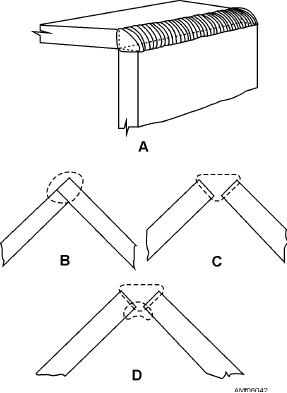
Acetylene Safety Precautions
sufficient filler metal is added to fuse or melt each plate
edge completely and to reinforce the joint.
Acetylene safety precautions should be rigidly
Light sheets are welded as shown in view B of
observed and enforced. Some of the more important
figure 6-41. No preparation is necessary other than to
precautions to remember are as follows:
clean the edges and tack weld them in position. The
1. Store acetylene cylinders in an upright
edges are fused together so no filler metal is required.
position. They must be securely fastened to prevent
The heavy plate joint, as shown in view C of figure
shifting or falling. Do not place cylinders on sides,
6-41, requires that the edges be beveled to secure good
drop, or handle roughly. If horizontal stowage is
penetration and fusion of the sidewalls. Filler metal is
necessary, or an acetylene cylinder is inadvertently left
used in this joint.
lying in a horizontal position, it must be placed in an
CORNER JOINTS.--Corner joints are used to
upright position for a minimum of 2 hours before it can
join two members located approximately at right angles
be used. (Otherwise, acetone in which the acetylene is
to each other in the form of an L. The fillet weld corner
dissolved will be drawn out with the gas.) Avoid
joint (view A of fig. 6-42) is used in the construction of
damaging the valves or fuse plugs to prevent leakage.
boxes, box frames, and similar fabrications.
2. Store acetylene cylinders in a well-protected,
The closed corner joint (view B of fig. 6-42) is used
well-ventilated, dry place, away from heating devices
on lighter sheets when high strength is not required at
or combustible materials.
the joint. In making the joint by oxyacetylene welding,
3. Use acetylene from cylinders only through
the overlapping edge is melted down, and little or no
pressure-reducing regulators. Do not use acetylene at
filler metal is added. When the closed joint is used for
pressures greater than 15 psi.
heavy sections, the lapped plate is V-beveled or
U-grooved to permit penetration to the root of the joint.
4. Open the acetylene valve slowly, 1/4 to 1/2
turn. This will permit an adequate flow of gas. Never
The open corner joint (view C of fig. 6-42) is used
open the valve more than 1 1/2 turns of the spindle.
on heavier sheets and plates. The two edges are melted
down, and filler metal is added to fill up the corner.
5. Keep sparks, flames, and heat away from
acetylene cylinders.
Corner joints on heavy plates are welded from both
sides, as shown in view D of figure 6-42. The joint is
6. Turn the acetylene cylinder so that the valve
first welded from the outside, and then reinforced from
outlet will point away from the oxygen cylinder.
the backside with a seal bead.
7. Do not interchange hose, regulators, or other
apparatus intended for oxygen with those intended for
acetylene.
8. Use only approved hoses and fittings with
acetylene equipment. Pure copper, or copper alloys
containing 67 to 99 percent copper, must not be used in
piping or fittings for handling acetylene (except
blowpipe or torch tips).
9. Test for leaks with soapy water--not with an
open flame.
10. Make no attempt to transfer acetylene from one
cylinder to another, refill an acetylene cylinder, or mix
any other gas or gases with acetylene.
11. Keep valves closed on empty cylinders.
12. Should an acetylene cylinder catch fire, use a
wet blanket to extinguish the fire. If this fails, spray a
stream of water on the cylinder to keep it cool.
13. Crack each cylinder valve for an instant to blow
dirt out of the nozzles before attaching the pressure
Figure 6-42.--Corner joints for sheets and plates.
6-28

